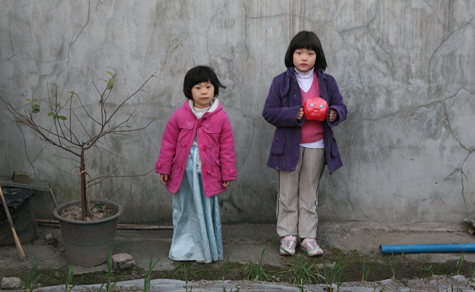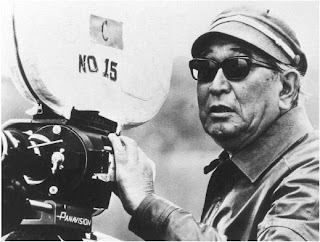
Directed by:
Park Kwang-hyun
Country of origin: South Korea (2005)
Starring:
Shin Ha-kyun, Jeong Jae-yoeng, Kang Hye-jeong
I'm kicking things off with the Korean film that helped inspire this blog.
Park Kwang-hyun's Welcome to Dongmakgol arrived to me during a time in which I was bored and completely uninspired. This film, fueled by its rich characters and its
stoic cause, raised me out of that slump. Like most Korean films,
Dongmakgol combines several genres (war, comedy, and drama), making for an incredibly unique cinematic experience. I approached it like any other film, yet partway through, I realized that Park's debut was slowly growing on me. At its end I was touched and, truthfully, near tears.
Welcome to Dongmakgol is one of the most
heartwarming and heartbreaking films I've ever seen. With its strikingly gorgeous cinematography and an ensemble of talented actors,
Dongmakgol is a film that really sneaks up on you. It planted a seed inside of me, one fertilized by a dose of empathy, one exposed to a world of simple beauty. At sudden points in the film, it suddenly hits you, and
Dongmakgol truly shines. Lets dive in.

At its heart, Welcome to Dongmakgol is a satire of Korean conflicts and a critique on the Korean War. Through comedy and irony, Dongmakgol tells a story set in the darkest times of Korea's history. The nation's people are in the middle of a brutal cival war, one that left the country divided and changed forever. Park showcases the brutalities of war, showing the tragic points of view from both the Northern and Southern soldiers. At the film's beginning, the viewer is thrust immediately into the lives of the battered and wounded soldiers. The violence is sudden and massive, and an amount of empathy is undeniably established as the deaths of young Korean men are framed so strikingly on-screen. Upon close escape of death, and as the viewer has a chance to stop and breathe in relief, Park comes in and gets to work. With the fluttering of dozens of white butterflies, the soldiers enter the new world that will come to cleanse them of their impending stresses. A common motif throughout Dongmakgol, the white butterflies seem to float freely through the mountain skies like Japanese blossoms. They symbolize life, and the profound effect its simple presence has. This is the message of Welcome to Dongmakgol, that the warring people of Korea should simply abandon their violence and revert back to their heritage, life dedicated to beauty and simplicity.

The villagers of Dongmakgol live innocent lives. Their world exists only as far as their village and the forests surrounding it. They neither know nor care what lies beyond the mountains cradling them, and nobly so. Kind and gentle like children, they know nothing of the savage war that rages below them, and they welcome any and all visitors with the utmost amount of respect and hospitality, like their ancestors did before them. This
simplicity is their way of life, and the central theme encompassing
Welcome to Dongmakgol.

When the soldiers wandered into the mountains, the gravity of their duties vanished, and to the villagers, any war High Comrade Lee and Second Lieutenant Pyo sought to rage against eachother was a simple argument. Firearms were sticks, and grenades were painted potatoes; to the villagers of Dongmakgol, these outsiders were just making a lot of noise about a simple feud. Words could resolve it, as far as they were concerned. And in this, Park Kwang-hyun and his intelligent screenplay make their point. The war and the soldier's grievances are made a mockery of in the presence of the villager's smart remarks and general cluelessness. In reality, the village is rounded up and held hostage at gunpoint by two factions of mortal enemies. But instead of being alarmed, the villagers appear to be more annoyed than anything. They have more pressing things to worry about than some pointless conflict between five strangers, like the wild boar thats been ravaging their food supply. They go about their hilarious, slapstick conversations and thus, the soldier's situation becomes nothing more than a silly standoff. Before they know it, the Northern and Southern soldiers were standing their, grenades and guns raised, for almost 24 hours straight, several of them struggling not to doze off while they remain standing. The situation is ridiculous and hilarious, and as the soldiers are drenched with rain and the villagers sit dry, giggling at the silly outsiders, the viewer begins to get it.

THE POPCORN SCENE
Eventually, though, the hostility between the soldiers does culminate in a violent resolution, and creates what I believe to be the central scene of Welcome to Dongmakgol. Still standing and completely exhausted, young Northerner Taik-gi fumbles a live grenade and the soldiers run for safety, Lieutenant Pyo attempting to save the village by jumping to cover it. Although it at first appears to be a dud, Pyo tosses it blindly backwards in relief and the grenade lands, ironically enough, in the Dongmakgol food supply, exploding on contact. The corn and potatoes that were meant to last the villagers through the winter were all gone, but instead of being an atrocity, the explosion became a thing of beauty as popcorn floated down upon the village like soft flakes of snow. The villagers beam and dance, beholding this amazing gift that the mountain provided them. In result, one of the most significant and radiant scenes of the Korean New Wave cinema is born.
 |
| Popcorn falls on Dongmakgol |

What makes this scene so successful is its clear symbolism and sudden shift in pace. Every physical element that upholds the popcorn scene is absolutely flawless, from the slow motion to the crisp depth to Hisaishi's angelic score. Upon exploding, it's almost as if the beautiful world surrounding it caused it to implode, and instead causing fear it caused joy. The air of simplicity that the village thrived on suffocated this man-made
weapon of destruction. And as the popcorn fell, the soldier's inhibitions are forgotten, and they seem just as moved by the downfall as the villagers. Their acts of violence, even in the extreme of an explosion, were not enough to shift the innocence of Dongmakgol. Pyo, Lee, and their men seemed to silently realize this, and their attitudes were changed and more temperate throughout the rest
of the film. It was almost as if the popcorn hypnotized them; their hatred was released, and they pondered skyward in awe and relief. Relief, so much, that the exasperated soldiers were finally lulled to sleep. The popcorn was like a lingering stun spore, the straw that broke the camel's back. The raging bears were coaxed into hibernation by an act of simple beauty, showcasing
Dongmakgol's central message. The villagers acted accordingly,
innocent and oblivious as always, despite their massive loss of food. They grasped the moment of beauty at hand and treasured it. This was the scene where
Dongmakgol truly began to move me. Master and legend of film score Joe Hisaishi composed music for the popcorn scene that absolutely
gleamed like the sun. It showcased the emotion and the tone of the scene flawlessly. A true goosebump effect. It is in this scene that you begin to realize how intoxicating the atmosphere of
Welcome to Dongmakgol is. You grow fond of the colorful characters and the pristine village that they reside in. And this emotional bond only grows from here, continuing to sneak up on you.
After their aggression is exhausted, things between the Northern and Southerners gradually improve, until respect and friendship is established, even between their zealous leaders Lee and Pyo. Any awkwardness is depleted as the men feast together on the boar they took down as a team. A simple human gesture of sharing food brought the warring people of North Korea, South Korea, and America
together. Park seems to dwell on this turning point in
Welcome to Dongmakgol, perhaps commenting how
the little things can make all the difference. The film itself indeed seems to live by that motto, taking time to explore the subtle beauties of the living and the inanimate alike. The soldiers spend the next few months helping the people of Dongmakgol replenish their food supply, and in doing so grow close with them and their way of life. Similarities between
Dongmakgol and Edward Zwick's epic
The Last Samurai arose in my mind. An outsider with a violent past, his presence obligated in a foreign place, proceeds to grow and adapt to the natural
beauty and simplicity surrounding him.
Once the soldiers in
Dongmakgol have to leave the village in order to save it from impending forces, sentimental moments between them and the villagers are heartbreaking. In the more serious moments of the film, Park did a fantastic job of making me feel pity for the victims. When the village chief is brutally beaten. When Pyo's flashback and past in finally fully revealed. The death of Yeo-il. Even the heartbreak of young Taik-gi. To me, the projected emotion was not a stretch, and I was moved in various instances throughout the film. In
Dongmakgol, the village idiot, of sorts, Yeo-il is mainly used as a source of comic relief. But she actually becomes a symbol of the
care-free lifestyle and the
presence of love in the world of Dongmakgol. Her dances in the rain and popcorn.
 |
| Yeo-il in the rain |
Her bright smile as she wiped the faces of the tired soldiers. Her simple gesture of love to Taik-gi revealed in the film's end. These action gave the film and the village its color. The villagers may have called her crazy, but Yeo-il held a special place in each of their hearts. Her charm begins to do the same to the viewer, and once she is killed, something vanishes and
Dongmakgol is no longer the same. Tragic defines it best.
Welcome to Dongmakgol is a beautiful film with a valuable message. While hilarious in parts, director Park has also discovered a way to move his audiences with instances of heartbreaking drama. To me, the film was inspiring, and reminded me
why I love East Asian cinema. It is a layered piece, and if you let it, it's stunning world will suck you in. In the end, after an apocalypse of sorts for the viewer has occurred, the white butterflies resurface from the snowy mountains and, in a very
Miyazaki-esque way of doing it, tell us that life and hope still remain. The ending is not entirely resolved, and most viewers will naturally want to see Capt. Smith return to Dongmakgol, but what happens to the villagers and the survivors is never known. But it doesn't need to be. As with many of Korea's greatest films,
Dongmakgol ends subtilely and satisfyingly, giving the viewer the closure they need yet leaving them with a taste for more. I'll say it once more, Welcome to Dongmakgol touched me; it warmed and broke my heart in all the right ways. It is quite the experience.
***** / *****



































